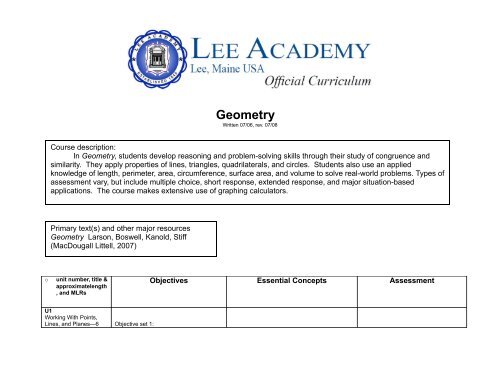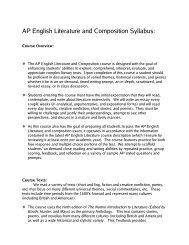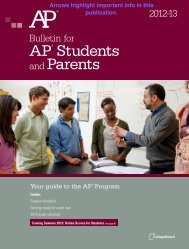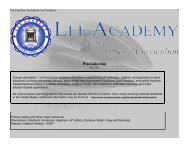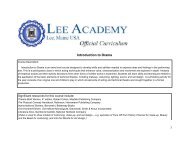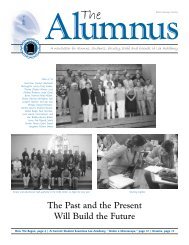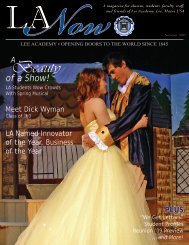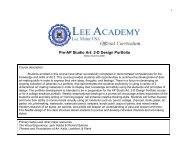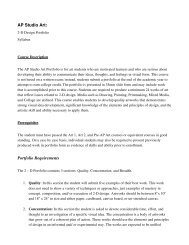Geometry - Lee Academy
Geometry - Lee Academy
Geometry - Lee Academy
You also want an ePaper? Increase the reach of your titles
YUMPU automatically turns print PDFs into web optimized ePapers that Google loves.
<strong>Geometry</strong><br />
Written 07/06, rev. 07/08<br />
Course description:<br />
In <strong>Geometry</strong>, students develop reasoning and problem-solving skills through their study of congruence and<br />
similarity. They apply properties of lines, triangles, quadrilaterals, and circles. Students also use an applied<br />
knowledge of length, perimeter, area, circumference, surface area, and volume to solve real-world problems. Types of<br />
assessment vary, but include multiple choice, short response, extended response, and major situation-based<br />
applications. The course makes extensive use of graphing calculators.<br />
Primary text(s) and other major resources<br />
<strong>Geometry</strong> Larson, Boswell, Kanold, Stiff<br />
(MacDougall Littell, 2007)<br />
o<br />
unit number, title &<br />
approximatelength<br />
, and MLRs<br />
Objectives Essential Concepts Assessment<br />
U1<br />
Working With Points,<br />
Lines, and Planes—6 Objective set 1:
weeks<br />
Goal set 1:<br />
Describe geometric<br />
figures. C<br />
Measure geometric<br />
figures. C<br />
Understand equality<br />
and congruence.<br />
C8<br />
3 classes--<br />
Student will:<br />
identify points, lines, and planes<br />
use segment postulates to identify<br />
congruent segments<br />
find lengths of segments in the<br />
coordinate plane, using midpoint and<br />
distance formulas<br />
use angle postulates to name,<br />
measure and classify angles<br />
use special angle relationships to find<br />
angle measures<br />
classify polygons<br />
find perimeter, circumference and<br />
area of polygons<br />
<br />
understanding of geometric figures and their<br />
basic relationships<br />
Goal set 2:<br />
Use inductive and<br />
deductive<br />
reasoning.<br />
Understand proofs<br />
of geometric<br />
relationships in<br />
diagrams.<br />
Learn essential<br />
geometric<br />
postulates and<br />
theorems<br />
Objective set 2:<br />
4 classes--<br />
Student will:<br />
describe patterns and use inductive<br />
reasoning.<br />
write definitions as conditional<br />
statements<br />
use postulates involving points, lines,<br />
and planes<br />
use properties from algebra to reason<br />
understand statements about<br />
segments and angles in proofs<br />
understand properties of special pairs<br />
of angles<br />
<br />
learn generally accepted statements that<br />
explain relationships in geometry, then use<br />
these statements to logically make<br />
relationships.<br />
Goal set 3:<br />
Use properties of<br />
Objective set 3:<br />
5 classes<br />
prove lines are parallel/identify angle<br />
pairs formed by three intersecting<br />
lines.<br />
use angles formed by parallel lines
parallel and<br />
perpendicular lines.<br />
Prove relationships<br />
using angle<br />
measures.<br />
Make connections<br />
to lines in algebra.<br />
<br />
<br />
<br />
and transversals.<br />
find and use slopes<br />
write and graph equations of lines<br />
find a distance between a point and a<br />
line<br />
<br />
relating algebra to geometry, to understand<br />
how they are connected and how each<br />
reinforces the other<br />
U2<br />
Triangles—8 weeks<br />
Goal set 4:<br />
Classify triangles by<br />
sides and angles.<br />
C8<br />
Prove that triangles<br />
are congruent .<br />
Use coordinate<br />
geometry to<br />
investigate triangle<br />
relationships. C8<br />
Objective set 4:<br />
7 classes<br />
Student will:<br />
classify triangles and find measures of<br />
their angles<br />
apply congruence and triangles<br />
use side lengths to prove triangles<br />
congruent<br />
use sides and angles to prove<br />
congruence<br />
use congruent triangles to prove<br />
corresponding parts congruent<br />
use theorems about isosceles and<br />
equilateral triangles<br />
create an image congruent to a given<br />
triangle (transformations)<br />
<br />
understand the basic geometric relations of<br />
angles and sides, and applying them to<br />
construction and architecture.<br />
<br />
At end of unit, use Ch4 Test, p286<br />
Goal set 5:<br />
Use properties of<br />
special segments in<br />
triangles. C8<br />
Use triangle<br />
inequalities to<br />
determine what<br />
triangles are<br />
possible. C8<br />
Extend methods for<br />
justifying and<br />
Objective set 5:<br />
3 classes<br />
Student will:<br />
use properties of mid-segments<br />
use perpendicular bisectors to solve<br />
problems<br />
use angle bisectors to find distance<br />
relationships<br />
use medians and altitudes of triangles<br />
find possible side lengths of a triangle<br />
<br />
understanding the special geometric links to<br />
measurement of distance, often used in<br />
astronomy and surveying.
proving<br />
relationships.<br />
Goal set 6:<br />
Use ratios and<br />
proportions to solve<br />
geometry problems<br />
Show that triangles<br />
are similar. C8<br />
Use indirect<br />
measurement and<br />
similarity.<br />
Objective set 6:<br />
6 classes<br />
Student will:<br />
write and solve proportions<br />
use proportions to solve geometry<br />
problems<br />
use proportions to identify similar<br />
polygons<br />
use proportionality theorems<br />
perform dilations (transformations)<br />
<br />
apply rules of proportion and scale to<br />
understand their use in real-world situations.<br />
U3<br />
Figures in the Plane—11<br />
weeks<br />
Goal set 7:<br />
Use the<br />
Pythagorean<br />
theorem and its<br />
converse. C8<br />
Use special<br />
relationships in right<br />
triangles. C8<br />
Use trigonometric<br />
ratios to solve right<br />
triangles. C8<br />
Objective set 7:<br />
11 classes<br />
Student will:<br />
apply Pythagorean theorem to find<br />
<br />
<br />
<br />
<br />
<br />
<br />
side lengths in right triangles<br />
use converse of Pythagorean theorem<br />
to determine if a triangle is a right<br />
triangle<br />
use properties of the altitude of a right<br />
triangle<br />
use relationships among the sides in<br />
special right triangles<br />
use the tangent ration for indirect<br />
measurement<br />
use the tangent, sine and cosine<br />
ratios<br />
use the inverse of tangent, sine and<br />
cosine ratios to solve triangles<br />
<br />
use trigonometric ratios to find unknown side<br />
lengths and angle measures in right<br />
triangles (e.g. find the length of a ski slope)<br />
<br />
Important: As part of the conclusion<br />
of this unit, use “Designing a Tent”<br />
Assessment (MAP)
Goal set 8<br />
Use angle<br />
relationships in<br />
polygons. C<br />
Use properties of<br />
parallelograms. C<br />
Classify<br />
quadrilaterals by<br />
their properties. C<br />
Objective set 8:<br />
7 classes<br />
Student will:<br />
find angle measures in polygons<br />
find angle and side measures in<br />
parallelograms<br />
use properties of rhombuses,<br />
rectangles and squares<br />
use properties of trapezoids and kites<br />
identify special quadrilaterals<br />
<br />
use proportions of quadrilaterals and other<br />
polygons to find side length and angle<br />
measures.<br />
Goal set 9:<br />
Perfom congruence<br />
and similarity<br />
transformations. C<br />
Make real-world<br />
connections to<br />
symmetry and<br />
tessellations. C<br />
Apply matrices and<br />
vectors in geometry.<br />
C<br />
Objective set 9:<br />
5 classes<br />
Student will:<br />
reflect a figure in any given line<br />
rotate figures about a point<br />
perform combinations of two or more<br />
transformations<br />
identify line and rotational symmetries<br />
of a figure<br />
<br />
show how to move two dimensional shapes<br />
on a plane, a skill that is useful in working<br />
with blueprints and graphic design.<br />
U4<br />
Circles and<br />
Measurement—13<br />
weeks<br />
Goal set 10:<br />
Use properties of<br />
segments that<br />
intersect circles. C9<br />
Apply angle<br />
relationships in<br />
circles. C9a<br />
Use circles in the<br />
coordinate plane. C<br />
Objective set 10:<br />
11 classes<br />
Student will:<br />
use properties of a tangent to a circle<br />
use angle measures to find arc<br />
measures<br />
use relationships of arcs and chords in<br />
a circle<br />
use inscribed angles and polygons<br />
find the measures of angles inside or<br />
outside a circle<br />
<br />
<br />
find segment lengths in circles<br />
write and graph equations of circles in<br />
the coordinate plane<br />
<br />
use properties of circles to investigate and<br />
model natural phenomena (e.g. the aurora<br />
borealis)
Goal set 11:<br />
Use area formulas<br />
for polygons. C<br />
Relate length,<br />
perimeter, and area<br />
ratios in similar<br />
polygons. C10<br />
Compare measures<br />
for parts of circles<br />
and the whole<br />
circle. C9b<br />
Objective set 11:<br />
11 classes<br />
Student will:<br />
find areas of triangles and<br />
parallelograms<br />
find areas of trazoids, rhombuses and<br />
kites<br />
use ratios to find areas of similar<br />
figures<br />
find arc lengths, circumference and<br />
other measures<br />
find the areas of circles and sectors<br />
find areas of regular polygons<br />
inscribed in circles<br />
use lengths and areas to find<br />
geometric probabilities<br />
<br />
apply formulas for perimeter, circumference,<br />
and area to find and compare measures<br />
(e.g. the lanes of an oval running track)<br />
Goal set 12:<br />
Explore solids and<br />
their properties<br />
C10.<br />
Solve problems<br />
using surface area<br />
and volume. C10<br />
Connect similarity to<br />
solids.<br />
Objective set 12:<br />
11 classes<br />
Student will:<br />
explore and identify solids<br />
find surface areas and volumes of<br />
prisms and cylinders<br />
find surface areas and volumes of<br />
pyramids and cones<br />
find surface area and volumes of<br />
sheres<br />
use properties of similar solids<br />
<br />
application of surface area and volume<br />
formulas to analyze real-world spaces (e.g.<br />
volume of a column on a building, volume of<br />
liquid calcium in a tractor tire)<br />
<br />
Important assessment, applying the<br />
skills and knowledge of this unit--<br />
“The Deep End” (MAP)


